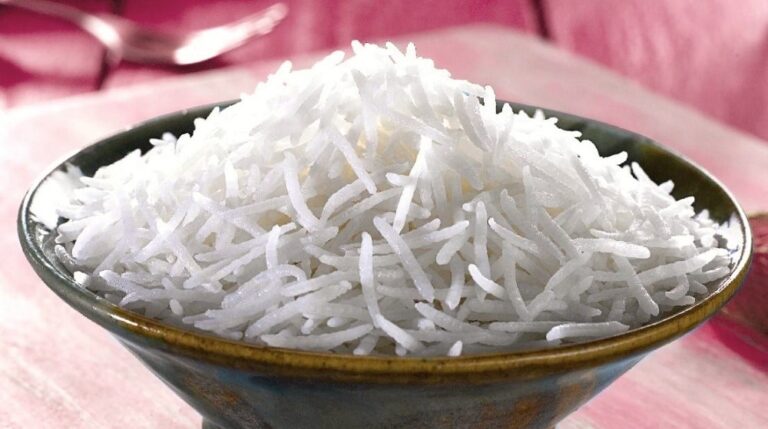Basmati rice is a long-grain rice used in Indian and Middle Eastern cuisine.
It has a nutty taste and a creamy, fluffy texture.
Basmati rice is normally steamed after being prepared in a saucepan with water or broth.
It may also be used in a number of recipes, including pilafs, stir-fries, and curries.
If you’re searching for a Basmati rice alternative, you have a few possibilities.
Basmati rice may be substituted with long-grain white rice, jasmine rice, or brown basmati rice.
This post will go through the five greatest Basmati rice replacements.
Contents
- What’s Basmati Rice?
- The 5 Best Substitutes for Basmati Rice
- Conclusion
- FAQs
- What rice is the same as basmati?
- Is jasmine rice a good substitute for basmati?
- Can you substitute basmati rice for white rice?
- What is Indian rice alternative?
- Is jasmine and basmati rice the same?
- What is basmati rice called in America?
- What is the healthiest rice to eat?
- Which rice is better than basmati?
- What is so special about basmati rice?
- What rice do Chinese restaurants use?
What’s Basmati Rice?

Basmati rice is a long-grain, aromatic rice.
It is indigenous to the Indian subcontinent and has been grown there for generations.
Basmati is a Sanskrit term that means fragrant or aromatic.
Basmati rice is distinguished by its nutty taste and light, fluffy texture.
Basmati rice grains stay distinct and do not cling together when cooked.
This makes it an excellent option for pilafs and biryani.
Basmati rice may be prepared in a number of ways, such as boiling, steaming, or frying.
It’s also a common element in many Indian dishes.
The 5 Best Substitutes for Basmati Rice
If you’re searching for a Basmati rice alternative, you have a few possibilities.
Based on flavor and texture, these are the five finest Basmati rice substitutes:
1 – Long Grain Jasmine Rice
Long-grain jasmine rice is an excellent choice for a versatile rice that can be used in a number of cuisines.
This rice has a mild, delicate taste that complements both savory and sweet foods.
Long-grain jasmine rice also has a somewhat sticky feel, making it ideal for stir-fries and other Asian-inspired meals.
It may, however, be used in place of basmati rice in other recipes.
Long-grain jasmine rice is a terrific choice for adding diversity to your dishes or just enjoying rice in a pleasant manner.
2 – Brown Rice
Brown rice is an excellent alternative for a nutritious and tasty rice.
Brown rice, as opposed to white rice, which has been processed and its bran and germ removed, preserves these nutritional layers.
This increases its fiber and vitamin content while also giving it a chewy texture and nutty taste.
Brown rice, when cooked correctly, is just as fluffy and tasty as white rice.
It may also be used in place of basmati rice in any dish.
Simply simmer it in water for 20-30 minutes, and you’re done.
3 – Long-Grain White Rice
Long-grain white rice is one of the most popular rice varieties worldwide.
It has a solid, somewhat chewy texture and a clean, neutral flavour.
It is often used as a side dish or as the primary element in Asian meals such as sushi and rice bowls.
Long-grain white rice is the most often used replacement for Basmati rice in the United States.
Basmati rice tastes and feels identical, but it is more costly and more difficult to buy in shops.
Long-grain white rice is an excellent substitute for Basmati rice if you are on a tight budget.
4 – Texmati Rice
If you like the flavor and texture of Basmati rice but want a healthy option, consider Texmati rice.
Texmati rice is a whole grain rice with a somewhat nutty taste that is high in nutrients.
It also has less calories and fat than Basmati rice.
Simply use the same quantities of water for rice as you would for Basmati when preparing Texmati rice.
The cooking time will be somewhat reduced, so check the rice often.
When it’s done, fluff it with a fork and serve.
Texmati rice may rapidly become your new favorite rice.
5 – Sushi Rice
Sushi rice is a form of short-grain rice used in Japanese cuisine.
It has a sticky texture and a somewhat sweet taste, making it perfect for sushi rolls.
Sushi rice is equally simple to prepare and may be used in place of Basmati rice in many dishes.
Sushi rice should be soft and somewhat chewy when cooked correctly.
It’s usually served with fish or vegetables and may be seasoned with vinegar, salt, and sugar.
Rinse the grains many times with water to eliminate any contaminants before making sushi rice.
The rice should then be cooked in an equal quantity of water until soft.
Finally, pour in the vinegar mixture and set aside to cool before serving.
Conclusion
Finally, there are some excellent Basmati rice replacements.
Each variety of rice has a distinct taste and texture, so selecting the appropriate one for your recipe is critical.
Long-grain jasmine rice is an excellent choice if you want a flexible rice that can be used in a number of meals.
For healthy and flavorful rice, try brown rice.
Long-grain white rice is a wonderful alternative to Basmati rice if you’re seeking for a less expensive option.
Whatever rice you select, be sure to thoroughly prepare it so that it is delicate and tasty.